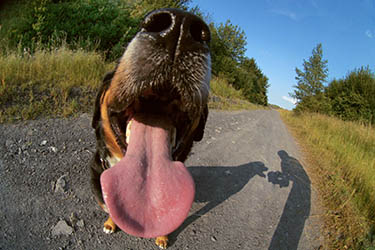Fighting the Most Common Cause of Doggie Breath | Periodontal Disease

It’s not uncommon for a dog to have stinky breath, but chronic halitosis is not normal. The following information highlights the most common cause of halitosis.
Periodontal Disease
Periodontal disease is the most common cause for bad dog breath, and is also one of the most frequent problems seen during veterinary examinations. Developing through the growth of bacteria, periodontal disease occurs in two forms: gingivitis and periodontitis.
Form #1. Gingivitis
- In a healthy dog’s mouth, the animal’s gums fit tightly around its teeth.
- However, if bacteria begins to develop between the teeth and gum line, the gums are pushed out and away from the teeth.
- Once the gums no longer fit tightly, pockets of dental calculus (tartar) form from trapped food particles, organic matter and bacteria.
- As the buildup of tartar continues, gingivitis occurs as the gums become infected.
- Halitosis is a characteristic sign, along with gum line irritation and inflammation shown by:
- Redness
- Swelling
- Bleeding
- Pain
- Pus
- In a healthy dog’s mouth, the teeth are held in place by cementum and connective tissue called the periodontal membrane.
- If gingivitis remains untreated and continues to progress, periodontitis will develop, attacking the cementum and periodontal membrane, and causing:
- Infection of the roots of the teeth
- Loosening of teeth
- Eventual loss of teeth
- Halitosis continues through periodontitis, along with signs of:
- Pain
- Reluctance to eat
- Shying away from having their head touched
- Difficulties when attempting to eat or pick up food
- Eating on only one side of its mouth
- Dropping of food as eating
- Drooling
- Swelling below the eye
- Sneezing after eating
- Purulent unilateral nasal discharge
- Food and water emitted out of the nose
- Oral-nasal fistula.


Working Here
Our team members are encouraged to be the best they can be... at Covetrus we believe we impact one another.
Learn MoreNews & Events
FDA Cautions Pet Owners Not to Feed Texas Tripe Inc. Raw Pet Food Due to Salmonella, Listeria Monocytogenes
The U.S. Food and Drug Administration is cautioning pet owners not to feed their pets any of the Texas Tripe brand raw frozen pet food listed below because several samples of Texas Tripe raw pet food have tested positive for Salmonella and/or L. mono.
Careers
Are you looking for a place to let your talents shine? At Covetrus, we help our practitioner customers better serve their patients and take pride in providing the best customer experience possible. Search our open positions to see our available opportunities.
Newsletter
Stay current with what’s going on with Covetrus, subscribe to receive our newsletter and email communications. Subscribers will receive the latest information in practice management, sales and marketing, animal health, and more.



-3-(1).png?sfvrsn=2d806d73_0)

Leave a comment